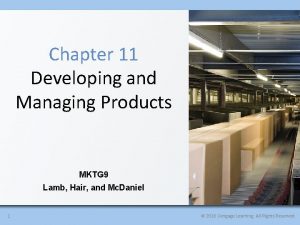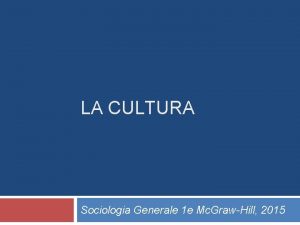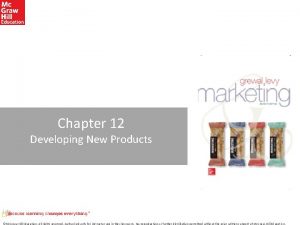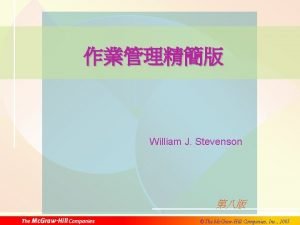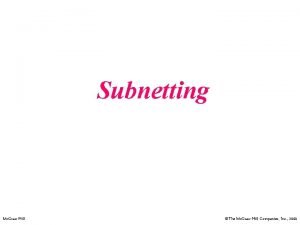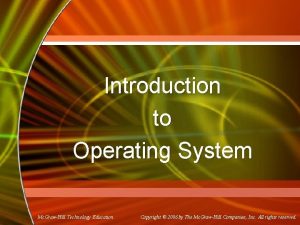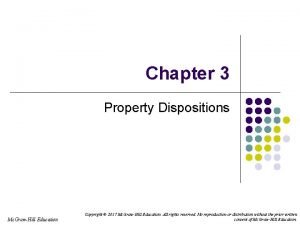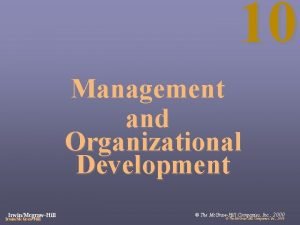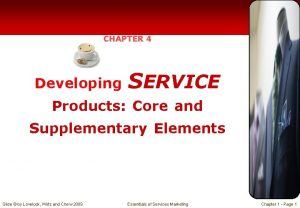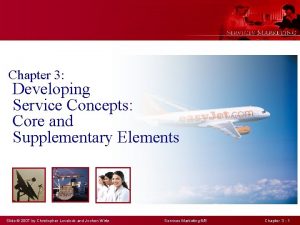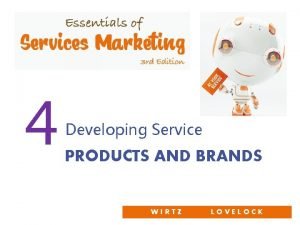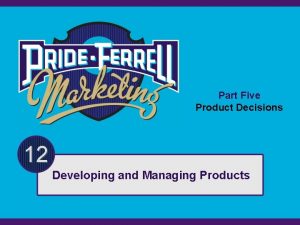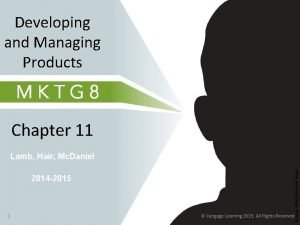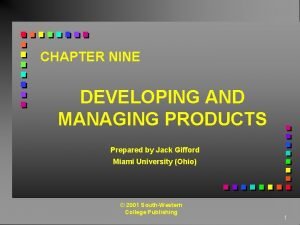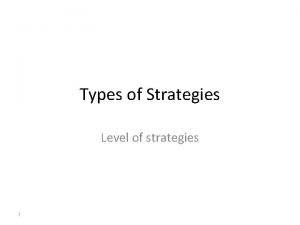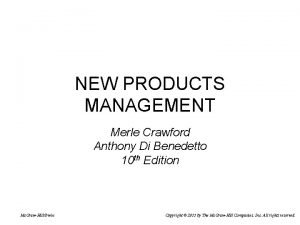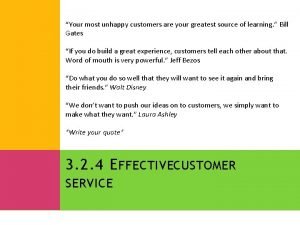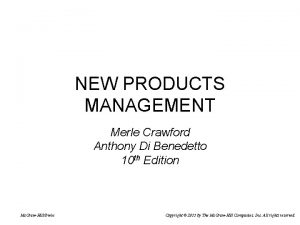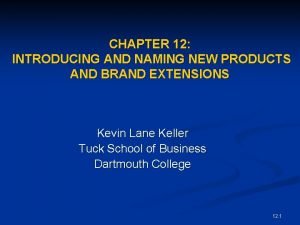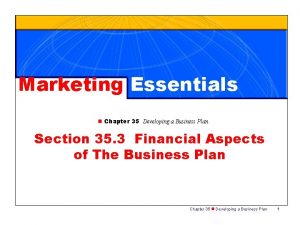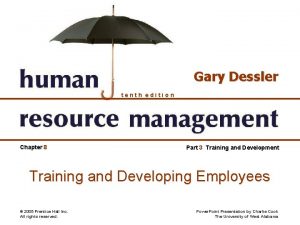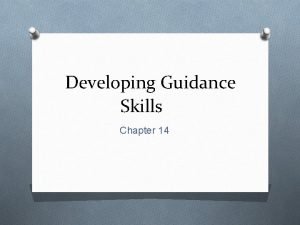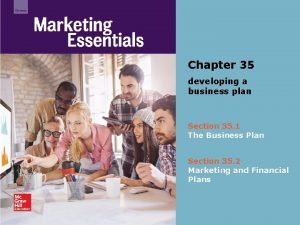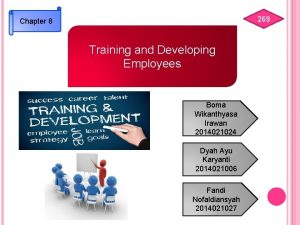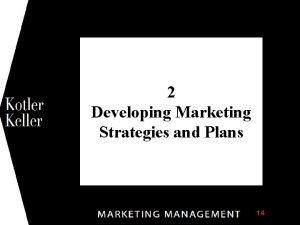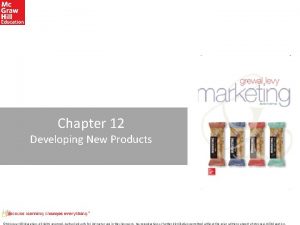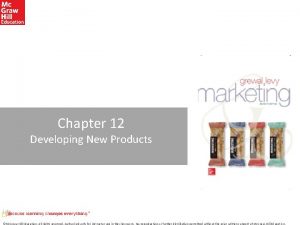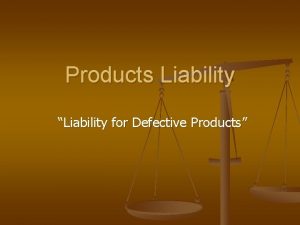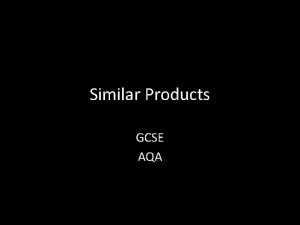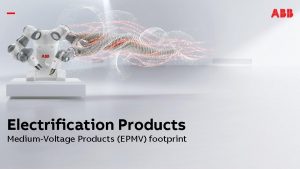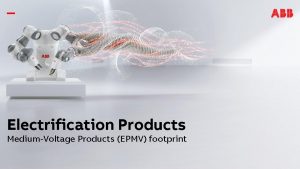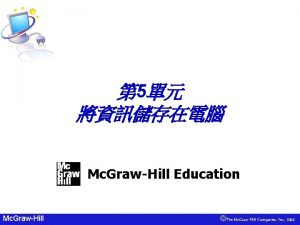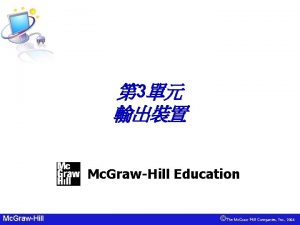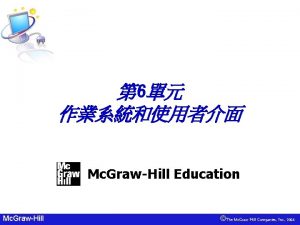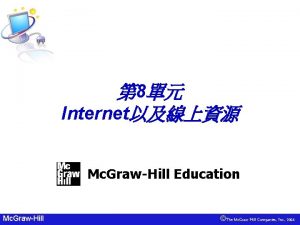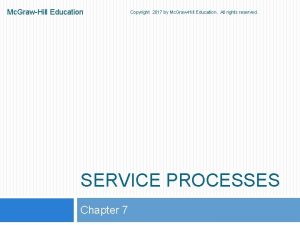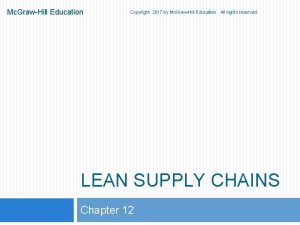Chapter 12 Developing New Products Mc GrawHill Education









































- Slides: 41

Chapter 12 Developing New Products ©Mc. Graw-Hill Education. All rights reserved. Authorized only for instructor use in the classroom. No reproduction or further distribution permitted without the prior written consent of Mc. Graw-Hill Education.

Learning Objectives Learning Objective 12. 1 Identify the reasons firms create new products. Learning Objective 12. 2 Describe the different groups of adopters articulated by the diffusion of innovation theory. Learning Objective 12. 3 Describe the various stages involved in developing a new product or service. Learning Objective 12. 4 Explain the product life cycle. 2 © Mc. Graw-Hill Education

First. Build 3 © Mc. Graw-Hill Education Courtesy of GE First. Build

Innovation and Value © Mc. Graw-Hill Education Jump to Appendix 1 long image description 4

PROGRESS CHECK (1 of 4) 1. What are the reasons firms innovate? 5 © Mc. Graw-Hill Education

Diffusion of Innovation The process by which the use of an innovation spreads throughout a market group over time and across categories of adopters. Pioneers or breakthroughs establish completely new markets or radically change competition and consumer preferences. Pioneers have the advantage of being first movers. 6 © Mc. Graw-Hill Education ©Stephen Lam/Reuters/Alamy Stock Photo

Product Failures 7 © Mc. Graw-Hill Education

Exhibit 12. 2: Diffusion of Innovation © Mc. Graw-Hill Education Jump to Appendix 2 long image description source: Adapted from Everett M. Rodgers, Diffusion of Innovation (New York: Free Press, 1983). 8

Identify the Adopter The first year they were offered, John wanted a tablet computer, but he did not know which one to choose. He waited until there were more choices, lower prices, and improved quality. John is part of the ______ diffusion of innovation group. Innovators Late Majority Tiffany always asks Samantha about beauty supply products. She considers her a well-informed friend who always knows the latest trends. For Tiffany, Samantha is a(n) ______ in the diffusion of innovation curve. Early Adopters Laggards Denise and Janet attend a large university in Texas. Denise asked for Janet’s e-mail address, but Janet said she didn't have one. Janet would probably be considered a(n) ______ in the diffusion of innovation process. © Mc. Graw-Hill Education Jump to Appendix 3 long image description Early Majority 9

Using the Diffusion of Innovation Theory Compatibility Relative Advantage Observability Factors Affecting Product Diffusion Complexity and Trialability 10 © Mc. Graw-Hill Education

PROGRESS CHECK (2 of 4) 1. What are the five groups on the diffusion of innovation curve? 2. What factors enhance the diffusion of a good or service? 11 © Mc. Graw-Hill Education

Exhibit 12. 3: The Product Development Process IDEA GENERATION CONCEPT TESTING PRODUCT DEVELOPMENT • Development of viable new product ideas. • Testing the new product idea among a set of potential customers. • Development of prototypes and/or the product. MARKET TESTING PRODUCT LAUNCH EVALUATION OF RESULTS • Testing the actual products in a few test markets. • Full-scale commercialization of the product. • Analysis of the performance of the new product and making appropriate modifications. © Mc. Graw-Hill Education Jump to Appendix 4 long image description 12

Exhibit 12. 4: Sources of New Product Ideas © Mc. Graw-Hill Education Jump to Appendix 5 long image description 13

Sources of New Product Ideas: Internal R&D High product development costs Often the source of technological products Often the source of breakthrough products 14 © Mc. Graw-Hill Education ©Tom Gannam/AP Images

Sources of New Product Ideas: R&D Consortia Firms join together to form research consortiums Lower costs and risks Benefits spread to all firms Example: pharmaceutical industry research 15 © Mc. Graw-Hill Education

Sources of New Product Ideas: Licensing Firms purchase the rights to technology or ideas from other research-intensive firms. University research centers often provide such licenses. 16 © Mc. Graw-Hill Education

Sources of New Product Ideas: Brainstorming Groups work together to generate ideas. No idea is immediately accepted or dismissed. Members vote on the best idea or combination of ideas. 17 © Mc. Graw-Hill Education

Sources of New Product Ideas: Outsourcing Hiring an outside firm to help generate ideas and develop new products and services. Design firms help clients generate new product and service ideas in industries such as health care, toys, and computers. 18 © Mc. Graw-Hill Education © 1001 slide/E+/Getty Images

Sources of New Product Ideas: Competitors’ Products Reverse engineering Copycat products 19 © Mc. Graw-Hill Education

Sources of New Product Ideas: Customer Input Listening to the customer in both B 2 B and B 2 C markets can lead to successful idea generation. Lead users: innovative product users who modify existing products according to their own specific needs. 20 © Mc. Graw-Hill Education ©Big Cheese Photo/Super. Stock

The Product Development Process: Concept Testing A concept is a brief written description of the product. Concept testing is the process in which the concept is presented to potential buyers or users to obtain their reactions. It triggers the marketing research process. 21 © Mc. Graw-Hill Education

The Product Development Process: Product Development or Product Design Prototype Alpha testing Beta testing 22 © Mc. Graw-Hill Education ©Nick Wass/AP Images

The Product Development Process: Market Testing Premarket tests Test marketing Customers exposed to product Mini product launch Customers surveyed More expensive than premarket tests Firm makes decision Market demand is estimated 23 © Mc. Graw-Hill Education

The Product Development Process: Product Launch This step requires tremendous financial resources and extensive coordination of all aspects of the marketing mix. The firm confirms its target market(s), decides how the product will be positioned, finalizes the remaining marketing mix variables, and determines the marketing budget. Timing of the launch may be critical. 24 © Mc. Graw-Hill Education

Do you think these product launches were successful? Kellogg’s Drink’n Crunch Portable Cereals • An inner cup contains the cereal and the outer cup contains the milk. Minute Maid Premium Heart Wise Orange Juice • Each 8 oz. serving of the juice contains 1 gram of plant sterols that can reduce cholesterol levels. Aquafresh Floss ‘N’ Cap Fluoride Toothpaste • The cap of the toothpaste contains floss. 25 © Mc. Graw-Hill Education

The Product Development Process: Evaluation of Results Satisfaction of technical requirements Degree of customer acceptance Satisfaction of the firm’s financial requirements 26 © Mc. Graw-Hill Education

PROGRESS CHECK (3 of 4) 1. What are the steps in the new product development process? 2. Identify different sources of new product ideas. 27 © Mc. Graw-Hill Education

The Product Life Cycle Defines the stages that products move through as they enter, get established in, and ultimately leave the marketplace. A useful tool in marketing strategy planning. Reflects marketplace trends. 28 © Mc. Graw-Hill Education

Exhibit 12. 5: Product Life Cycle © Mc. Graw-Hill Education Jump to Appendix 5 long image description 29

Exhibit 12. 6: Characteristics of Different Stages of the Product Life Cycle Introduction Growth Maturity Decline Sales Low Rising Peak Declining Profits Negative or low Rapidly rising Peak to declining Declining Innovators Early adopters and early Late majority Typical consumers Competitors (number of firms and products) One or few Few but increasing Laggards High number of competitors Low number and of competitors competitive and products 30 © Mc. Graw-Hill Education

The Introduction Stage of the PLC 31 © Mc. Graw-Hill Education

The Growth Stage of the PLC 32 © Mc. Graw-Hill Education

The Maturity Stage of the PLC 33 © Mc. Graw-Hill Education

The Decline Stage of the PLC 34 © Mc. Graw-Hill Education

Limitations of Product Life Cycle Each product or service has its own shape. Challenging to know precisely the stage of the PLC. 35 © Mc. Graw-Hill Education

Service Any intangible offering that involves a deed, performance, or effort that cannot be physically possessed. By providing good customer service, firms add value to their products and services. 36 © Mc. Graw-Hill Education

The Service-Product Continuum Most offerings lie somewhere in the middle. ; © Mc. Graw-Hill Education Jump to Appendix 1 long image description 37

Services Marketing Differs from Product Marketing 38 © Mc. Graw-Hill Education

Evaluating Service Quality Using Well. Established Marketing Metrics © Mc. Graw-Hill Education Jump to Appendix 3 long image description 39

PROGRESS CHECK (4 of 4) 1. What are the key marketing characteristics of products or services at each stage of the product life cycle? 2. Why might placement decisions for products or services into stages of the product life cycle become a self-fulfilling prophecy? 40 © Mc. Graw-Hill Education

Marketing Chapter 12 The End
 Developing new products and services
Developing new products and services Chapter 11 developing and managing products
Chapter 11 developing and managing products Grawhill
Grawhill Grawhill
Grawhill 作業管理精簡版13版解答
作業管理精簡版13版解答 Grawhill
Grawhill Mc grawhill
Mc grawhill Mc grawhill
Mc grawhill Grawhill
Grawhill Mc grawhill
Mc grawhill Grawhill
Grawhill Developing service products core and supplementary elements
Developing service products core and supplementary elements Elements of flower of service
Elements of flower of service The flower of service model
The flower of service model Developing and managing products
Developing and managing products Developing and managing products
Developing and managing products Developing and managing products
Developing and managing products Functional products
Functional products Pepsi 4ps marketing mix
Pepsi 4ps marketing mix Unit 4 school education system
Unit 4 school education system Chapter 16 toward a new heaven and a new earth
Chapter 16 toward a new heaven and a new earth Adding new, unrelated products or services
Adding new, unrelated products or services Processing used materials into new products
Processing used materials into new products New products management
New products management Adding new unrelated products or services
Adding new unrelated products or services New products management
New products management Cummins power unit
Cummins power unit Your most unhappy customers are your greatest
Your most unhappy customers are your greatest New products management
New products management Introducing and naming new products and brand extensions
Introducing and naming new products and brand extensions Introducing and naming new products and brand extensions
Introducing and naming new products and brand extensions Chapter 35 developing a business plan
Chapter 35 developing a business plan Chapter 8 training and developing employees
Chapter 8 training and developing employees Chapter 15 developing fraction concepts
Chapter 15 developing fraction concepts Guidance skills definition
Guidance skills definition Chapter 35 developing a business plan
Chapter 35 developing a business plan Chapter 2 developing marketing strategies and plans summary
Chapter 2 developing marketing strategies and plans summary Chapter 18 preparing for the world of work
Chapter 18 preparing for the world of work Chapter 8 training and development
Chapter 8 training and development Chapter 3 lesson 2 health
Chapter 3 lesson 2 health Developing a vast wilderness
Developing a vast wilderness The marketing plan the central instrument
The marketing plan the central instrument

